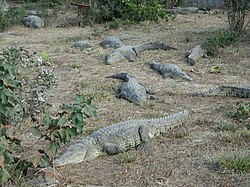Crocodylus
| Crocodylus | ||||||||||||
|---|---|---|---|---|---|---|---|---|---|---|---|---|
 Nilkrokodile (Crocodylus niloticus) | ||||||||||||
| Systematik | ||||||||||||
| ||||||||||||
| Wissenschaftlicher Name | ||||||||||||
| Crocodylus | ||||||||||||
| Laurenti, 1768 |
Die Gattung Crocodylus stellt die größte Gattung der Krokodile (Crocodylia) und dort der Echten Krokodile dar. Sie umfasst 13 Arten, die in den tropischen Regionen Afrikas, Asiens und Ozeaniens sowie Südamerikas anzutreffen sind.
Merkmale
Crocodylus-Arten sind mittelgroße bis sehr große Krokodile, die im Vergleich zu den Stumpfkrokodilen (Osteolaemus) längere Schnauzen haben, aber genau wie diese, im Gegensatz zum Sunda-Gavial, weniger als 20 Zähne je Oberkieferseite und klar getrennte Nacken- und Rückenschuppen aufweisen.[1] Die Arten der Gattung unterscheiden sich von allen anderen Echten Krokodilen durch vier Synapomorphien des Skeletts: eine taillenartige Einbuchtung am Darmbein (Ilium), mehrere Einbuchtungen auf der Innenseite des Oberkieferknochens, einen gegabelten vorderen Ectopterygoidfortsatz und ein bei seitlicher Betrachtung des Unterkiefers sichtbares Os articulare.[2]
Systematik
Der Gattung gehören neben mehreren fossilen Arten 13 heute vorkommende Arten an.[2][3] Wie das nebenstehende Kladogramm zeigt sind drei der gegenwärtig anerkannten Crocodylus-Arten nicht monophyletisch, sondern bestehen aus mindestens zwei Kladen mit unterschiedlicher Stellung im Kladogramm. Dabei handelt es sich um das Nilkrokodil, das Siam-Krokodil und das Leistenkrokodil.[4]
Kladogramm der nächsten Verwandtschaftsverhältnisse, anhand von DNA-Analysen einer Studie von Lee und Yates aus dem Jahr 2018:[5]
| Crocodylinae |
| ||||||||||||||||||||||||||||||||||||||||||||||||||||||||||||||||||||||||||||||||||||||||||||||||||||||||||||
Der nächste Verwandte des südlichen Neuguineakrokodils (Crocodylus halli), welches erst 2019 als separate Spezies deklariert wurde, ist das Nördliche Neuguinea-Krokodil.[6]
Literatur
- Charles A. Ross (Hrsg.): Krokodile und Alligatoren – Entwicklung, Biologie und Verbreitung. Orbis Verlag, Niedernhausen 2002.
Weblinks
Einzelnachweise
- ↑ Jay Mathers Savage: The amphibians and reptiles of Costa Rica: a herpetofauna between two continents, between two seas. University of Chicago Press, 2002, ISBN 978-0-226-73537-5, S. 778.
- ↑ a b Christopher A. Brochu: Phylogenetic Relationships and Divergence Timing of Crocodylus Based on Morphology and the Fossil Record. In: Copeia. Nr. 3, 2000, S. 657–673 (englisch).
- ↑ Christopher M. Murray, Peter Russo, Alexander Zorrilla und Caleb D. McMahan. 2019. Divergent Morphology among Populations of the New Guinea Crocodile, Crocodylus novaeguineae (Schmidt, 1928): Diagnosis of An Independent Lineage and Description of A New Species. Copeia. 107(3); 517-523. DOI: 10.1643/CG-19-240
- ↑ Robert W. Meredith, Evon R. Hekkala, George Amato, John Gatesy: A phylogenetic hypothesis for Crocodylus (Crocodylia) based on mitochondrial DNA: Evidence for a trans-Atlantic voyage from Africa to the New World. Molecular Phylogenetics and Evolution, Volume 60, Issue 1, July 2011, Pages 183-191, doi: 10.1016/j.ympev.2011.03.026
- ↑ M. S. Y. Lee & A. M. Yates (2018): Tip-dating and homoplasy: reconciling the shallow molecular divergences of modern gharials with their long fossil record. Proceedings of the Royal Society B Proc Biol Sci. 2018;285(1881):20181071. doi:10.1098/rspb.2018.1071
- ↑ New species of crocodile discovered in museum collections Science Daily, aufgerufen am 7. März 2022
Auf dieser Seite verwendete Medien
Autor/Urheber: User:Sagqs, Lizenz: CC-BY-SA-3.0
World distribution of species within genus Crocodylus: Left:
- Crocodylus acutus
- Crocodylus rhombifer
- Crocodylus moreletii
- Crocodylus intermedius
- Crocodylus niloticus
- Crocodylus cataphractus = Mecistops cataphractus
Right:
- Crocodylus palustris
- Crocodylus porosus
- Crocodylus siamensis
- Crocodylus mindorensis
- Crocodylus novaeguineae
- Crocodylus johnsoni
but not:


